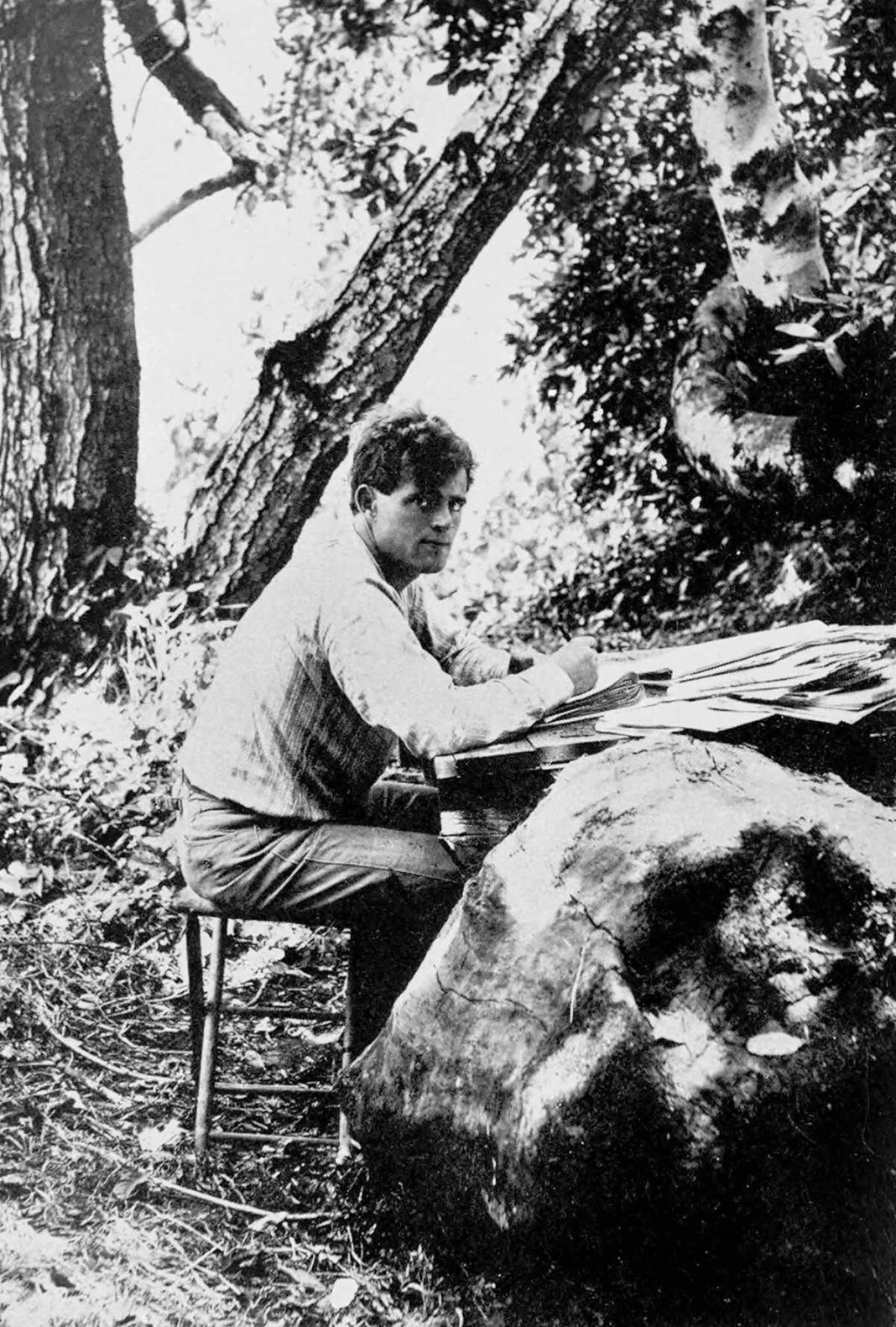A new guide book for the San Francisco Bay Area offers dozens of exhilarating walks, hikes and historical sites for locals and tourists. A People’s Guide to the San Francisco Bay Area mentions Jack London’s The Call of the Wild, a socialist fable disguised as a dog story, but it doesn’t locate any of the places associated with the author. That’s a pity.
For nearly 40 years, the San Francisco Bay Area was London’s stomping ground. In his heyday, he signed his letters, “Yours for the revolution” and added his alias, “Wolf.” A social animal and also a loner, he blazed a literary trail that Hemingway, Kerouac, Cormac McCarthy and others followed.
No 20th-century writer dug deeper roots in the Bay Area than London. And no writer captured its essence more fully than he did, in books like Martin Eden, about a writer who becomes famous and takes his own life, and The Valley of the Moon, which begins in Oakland and ends in Glen Ellen in Sonoma County. A troublemaker and a fiery public speaker, he ran for mayor of Oakland twice, but didn’t allow campaigning to interfere with his writing schedule. Had he lived to 100 or so, London probably would have campaigned for Bernie Sanders. Along with his devoted readers, he called for the eight-hour work day, an end to the exploitation of child labor and the right to speak freely.
Curious folks can take in the highpoints of London’s world in a single day. That means traveling from Oakland, where the author roamed the waterfront, to Berkeley, where he attended the University for a semester, and then to San Francisco, where he was born on Jan. 12, 1876 to a spiritualist and her live-in lover, William Henry Chaney. London was the name of his stepfather.
That day-long journey around the Bay would then end in Glen Ellen, where London died on Nov. 22, 1916, at the age of 40, an alcoholic, a workaholic and a visionary who almost single-handedly created the field of California literature. Beauty Ranch, where he raised horses and pigs, and aimed to grow crops organically, is now Jack London State Historic Park. I’ve visited it dozens of times and have introduced it to tourists from France and Germany who love the spectacular hikes.
Adults and kids of all ages are inspired by the recently revamped museum at House of Happy Walls, where Jack’s widow, Charmian, lived for several decades. The big surprise is the ruins of Wolf House, the mansion that burned down in a fire in 1913. Jack thought it was arson, though no one was ever charged and arrested.
The waters of San Francisco Bay lay at the heart of London’s world. One can view them from the shore in Oakland and in San Francisco, and one can literally feel and smell them on a boat ride to Alcatraz, the island that once housed a federal prison and is now a tourist destination.
London wrote about San Francisco Bay in books such as The Fish Patrol, available in an inexpensive, attractive edition from Heyday Press, a local publisher. After making a living as “an oyster pirate,” London worked for the fish patrol to apprehend pirates. Oysters are available at Hog Island Oyster Company in San Francisco’s historic Ferry Building.
Jack London Square in Oakland boasts the restored cabin where London lived when he prospected for gold in the Yukon. The Square also boasts “Heinhold’s First and Last Chance Saloon,” where the author consumed great quantities of alcohol, studied the bartender’s dictionary and amassed a vocabulary.
The Square is home to stores, restaurants, hotels and an Amtrak Station. One could arrive by train from L.A. or Sacramento and eat breakfast at the Oakland Grill, the Buttercup, the Chop Bar or the Seawolf, which is named after London’s demonic captain, “Wolf” Larsen: a wolf of a man. It serves breakfast burritos and other Mexican favorites.
For a time, Oakland residents wanted to erase the name Jack London from the Square, on the grounds that the author uttered racist comments. Jack London wrote a lot about Asians and Asia. One of his basic fears was that the Japanese and the Chinese would forge an anti-American alliance and make life difficult for the U.S.A. politically and economically. He called it “The Yellow Peril.” In fact, the Chinese and the Japanese became intense adversaries. London covered the war between the Russians and the Japanese in 1904-1905. When Japanese military forces defeated the Russians on the battlefield, London was shocked. He couldn’t believe that Asian soldiers defeated “white” soldiers. London had Asian servants, but he never regarded Asians as his equals. They could help him dress and prepare him for bed, but they were never friends. “Paternalistic” is how one might characterize his outlook.
Bay Area Born
From the heart of Oakland, it’s a short car ride across the Bay Bridge to Third Street and Brannan in San Francisco, where a plaque marks London’s birthplace. The house where he lived briefly as an infant burned down in the fires that accompanied the 1906 San Francisco Earthquake, an event London wrote about for Collier’s magazine. He also took dozens of black-and-white photos that document the damage. Some of them can be viewed on the website for the California Department of Parks and Recreation (www.parks.ca.gov/).
The smoke from the fires reached all the way to London and his second wife, Charmian Kittredge, on their mountain top in Glen Ellen. They packed their bags, decamped for the city and recorded the catastrophe. As a journalist, London also contributed regularly to the San Francisco Examiner, the newspaper made famous by William Randolph Heart, a.k.a. “Citizen Kane,” that’s now free and in boxes nearly everywhere. “San Francisco is like the crater of a volcano,” London wrote on May 5, 1906 in “The Story of an Eyewitness” and with the city still smoldering. “The bankers and the businessmen have already set about making preparations to rebuild.”
Glen Ellen was, in London’s day, a sleepy hamlet. It still doesn’t have a Starbucks, a McDonald’s or a Walmart. That’s part of its charm. But there are good places to eat, including the Glen Ellen Star and the Fig Café, which have offered take-out all through the pandemic. There’s also the Jack London Saloon, a place one can go to soak up ambiance.
Jack London Ranch Road climbs from the valley floor into the hills until it arrives at Jack London State Historic Park, which has been staffed and operated for years by locals, with help from Sacramento.
In the early 20th century, visitors often took the train to Glen Ellen. Alas, that’s no longer possible. But the drive by car, whether on Highways 12, 116 or 37, runs across eye-popping landscapes and along cascading vineyards. Due to Covid-19, visitors can’t visit the museum at House of Happy Walls, once Charmian London’s home. Also off-limits is the cottage which boasts artifacts she and Jack collected during their globetrotting days.
Despite the pandemic, visitors walk, bicycle and gallop on horseback across a huge estate where London built a sturdy silo and a round house for pigs that the media called “a palace.” Picnic tables are available, as are restrooms. The old buildings, which were constructed with rocks and stones from the valley floor, exude the kind of romance that tourists often associate with Rome and Venice.
London scholar and Santa Rosa resident, Susan Nuernberg, tells me that visitors to the park enjoy the miles of well-maintained trails. “The scenery is beautiful and the views are spectacular,” Nuernberg says. “Hikers can climb all the way to the top of Sonoma Mountain, or they can circumnavigate the peak. The signage is good.”
The further away from paved roads, telephone poles and houses, the more you feel you’re in the wilderness.
In a state such as California, where old buildings are routinely torn down to make room for new buildings, the ruins of Wolf House are truly unusual. Gazing at the outlines of the chimneys that reach for the sky, and musing on the stone walls, one can imagine the grandeur of the home which London hoped would last 1,000 years.
So much for the big dreams of the bestselling author who wrote 50 books in less than 20 years, even as he welcomed a steady stream of visitors that included artists, translators, anarchists and ex-cons. London served them martinis and regaled them with tales of his own adventures, which still stir scholars such as Geoff Dunn, a Santa Cruz journalist, historian and London expert.
“Jack was one of the most important American writers from about 1900 to the start of World War I,” Dunn tells me. “His stories have traction; he’s still widely read and his insights about poverty and social stratification are as valid as ever.”
London’s memoir, The Road, led to Kerouac’s On the Road; his novel The Iron Heel gave birth to Orwell’s 1984; and his first-person reporting on the war between the Russians and the Japanese in 1904–1905 opened a door for journalists who battled government censorship in World War I.
Before you explore London’s Bay Area you might want to read or reread The Call of the Wild, White Fang or The Sea-Wolf.
East Coast literary stars who ought to know better habitually turn up their noses at Jack and his oeuvre. That’s their loss.











